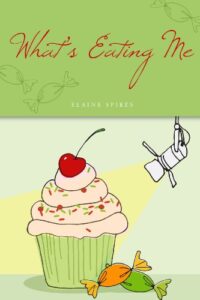In the first of two articles Elaine Spires shares the secrets of turning a stage play into a novel
My first novel, What’s Eating Me, started life as a stage play. It’s the story of Eileen Holloway, a struggling single parent of two teenage boys who’s holding down a demanding job while dealing with her difficult mother. Food is the drug of choice that gets her through the day until she is tricked into appearing on Barbara’s Beautiful Bodies, a reality TV show. She becomes a celebrity over night, albeit a reluctant one. Compulsive overeating is a grossly misunderstood condition and it was a story I was keen to tell.
The play was a one-woman show, which I took to the Edinburgh Fringe. Although we played in a tiny venue, it had great reviews. Afterwards, though, I just couldn’t let Eileen go. So I decided to turn her story into my first book.
As the play was a three-act soliloquy – Eileen sharing her thoughts with the audience – it seemed to me logical that the book should be written in the first person (I) as this would tell Eileen’s story in her own voice, giving it an intimacy that would have been missing in the third person (she).
A huge advantage for a writer turning a play into a novel is that the characters have already been brought to life and their voices have been heard. A great tip for writing novels, especially dialogue, is to read your words out loud to hear the characters’ voices and when converting a play this part has already been done for you. Your characters are already 3-dimensional and alive; you’ve seen and heard them. The audience feedback i.e. where they reacted by laughing, gasping, clapping, stunned silences or – hopefully not – bored indifference is also a great indicator of what’s working and what isn’t, not just re dialogue but also plot twists and story arc. I would recommend watching your play performed as many times as possible. You’ll be surprised that you see something different every time. Actor input also plays a helpful, vital role.
 Regardless of when events and back stories appeared in the play my first step was to put them into chronological order thus giving me a time line of scenes. Then I worked on each scene, developing character/personality traits, adding or expanding on backstory thus giving not only deeper insights to the individual characters but explaining, in this case, Eileen’s reactions to them. This I call sprinkling the glitter – where the creative process really gets to work. It’s the part where ideas often appear from nowhere that move the plot along or take it in a different direction. This, in turn, helped demonstrate the Why behind Eileen’s self-destructive behaviour. In the end, although the main events of the story occur in diary form in the novel, backstory events are revealed as and when the plot demands it, thus producing twists. And everyone loves a twist, don’t they? Perhaps this sounds complicated but with detailed A3 sheets on the wall covered in post-it notes, it worked for me.
Regardless of when events and back stories appeared in the play my first step was to put them into chronological order thus giving me a time line of scenes. Then I worked on each scene, developing character/personality traits, adding or expanding on backstory thus giving not only deeper insights to the individual characters but explaining, in this case, Eileen’s reactions to them. This I call sprinkling the glitter – where the creative process really gets to work. It’s the part where ideas often appear from nowhere that move the plot along or take it in a different direction. This, in turn, helped demonstrate the Why behind Eileen’s self-destructive behaviour. In the end, although the main events of the story occur in diary form in the novel, backstory events are revealed as and when the plot demands it, thus producing twists. And everyone loves a twist, don’t they? Perhaps this sounds complicated but with detailed A3 sheets on the wall covered in post-it notes, it worked for me.
I thoroughly enjoyed this way of writing and so another play – Sweet Lady – became my second novel. And this book, too, is written in first person, although quite different from What’s Eating Me. The rest of my novels haven’t been plays but I always visualise them as such, making notes and envisaging scenes of dialogue, which I perform aloud – fortunately I live alone – before I start the proper writing of the book.
Readers often remark that my books would make great TV series. I think that’s the result of the way I plan.
www.elainespires.co.uk

